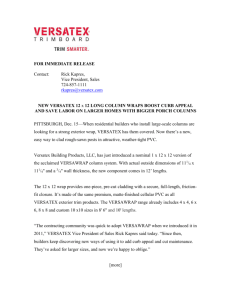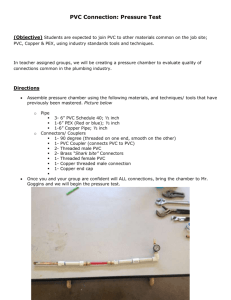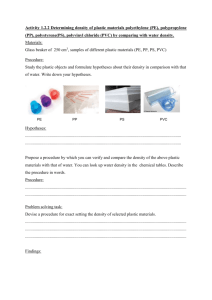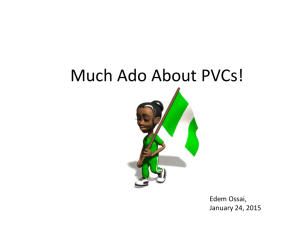Lesson: What is PVC?
advertisement
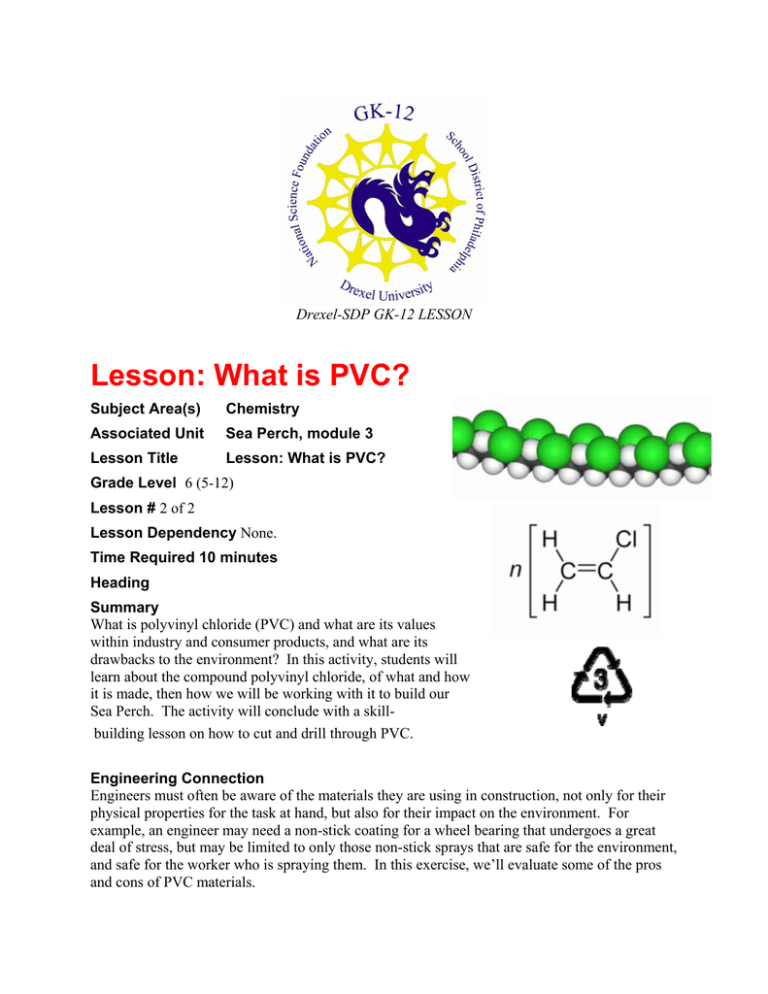
Drexel-SDP GK-12 LESSON Lesson: What is PVC? Subject Area(s) Chemistry Associated Unit Sea Perch, module 3 Lesson Title Lesson: What is PVC? Grade Level 6 (5-12) Lesson # 2 of 2 Lesson Dependency None. Time Required 10 minutes Heading Summary What is polyvinyl chloride (PVC) and what are its values within industry and consumer products, and what are its drawbacks to the environment? In this activity, students will learn about the compound polyvinyl chloride, of what and how it is made, then how we will be working with it to build our Sea Perch. The activity will conclude with a skillbuilding lesson on how to cut and drill through PVC. Engineering Connection Engineers must often be aware of the materials they are using in construction, not only for their physical properties for the task at hand, but also for their impact on the environment. For example, an engineer may need a non-stick coating for a wheel bearing that undergoes a great deal of stress, but may be limited to only those non-stick sprays that are safe for the environment, and safe for the worker who is spraying them. In this exercise, we’ll evaluate some of the pros and cons of PVC materials. Keywords PVC, polymers, construction, chemistry Educational Standards • Science: Technology Education – Physical Technologies 3.6.C., Science, Technology and Human Endeavors – Meeting Human Needs 3.8.B, Science, Technology and Human Endeavors – Consequences and Impacts 3.8.C • Math: Computation and Estimation 2.2 Pre-Requisite Knowledge Be familiar with some basic elements in the periodic table Learning Objectives After this lesson, students should be able to: • Know what PVC stands for • Give three examples of things that PVC is used for • List some of the pros and cons of PVC materials Introduction / Motivation What is polyvinyl chloride (PVC) and what are its values within industry and consumer products, and what are its drawbacks to the environment? In this activity, students will learn about the compound polyvinyl chloride, of what and how it is made, then how we will be working with it to build our Sea Perch. The activity will conclude with a skill- building lesson on how to cut and drill through PVC. Lesson Background & Concepts for Teachers This activity will be conducted after some discussion what is PVC, how it is made, what are its uses within industry and consumer products, its impact on the environment, and how we will be working with it to build our Sea Perch. PVC: Stands for polyvinyl chloride, a thermopolastic polymer. Thermoplastic means it melts into a liquid and cools into a brittle, glassy solid. Polymer is a substance composed of repeating molecular units. Polys means many, and menos means many in the Greek language. In common use, polymer is used synonymously with plastic. PVC is often used in building materials and often replaces more expensive wood, concrete and clay. The first vinyl chloride was accidentally discovered by a scientist as early as the 1830s (Henri Victor Regnault), but it wasn't until 100 years later, in 1926 that Waldo Semon of B.F. Goodrich learned to plasticize the compound with additives, making it much more flexible and suitable for widespread commercial use. In consumer products, PVC is often used in plastic bottles such as those for detergent, clothing, and many soft baby toys. PVC poses some health risks, however, in that the additives used to plasticize the compound can leach out of the material and have been linked to carcinoma and other health problems. This is a concern when babies chew on the toys or when PVC is used in 2 IV bags for patients in hospitals. The alternatives for plasticization are generally more expensive. Another environmental concern in the use of PVC is that the chlorine in the compound produces poisonous dioxins that are released when PVC is incinerated in municipal waste facilities. Dioxins can travel great distances in the atmosphere and have been lined to immune system impairment, carcinoma and reproductive problems. Municipal waste incinerators are equipped to collect a portion of hazardous byproducts. Private backyard waste burning releases the dioxins when PVC is burned, and should be avoided at all costs. The code for recyclable PVC is shown at the top of page 1, however, PVC is often not recycled because the cost of post-consumer PVC far outweighs the cost of manufacturing new material. PVC has a density of 1380 kg/m3, making it slightly more dense than water (1000 kg/m3). What does that mean when PVC is used in construction for our Sea Perch? Will it sink or float when composed of PVC alone? Vocabulary / Definitions Word PVC Polymer Definition Stands for polyvinyl chloride, a thermopolastic polymer. A substance made of a repeated chain of man-made molecules, often referred to as ‘plastic’ Associated Activities Activity: Learn to Cut PVC Pipe Lesson Closure Follow with the Activity: Learn to Cut PVC Pipe Assessment Lesson Summary Assessment Ask to see the students’ notebooks to ensure they have recorded the lesson notes – design a short quiz of 5-6 questions to see if the students were listening. In addition, you may use the rubric below. Students will be evaluated on a scale from 0 to 4 on: ______________ _____________ Lesson Extension Activities Safety Following Instructions _____________ _____________ Task Completion Comprehension Activity: Learn to Cut PVC Pipe Contributors: Dara Kusic Copyright: Copyright 2007 Drexel University GK12 Program. Reproduction permission is granted for non-profit educational use 3


